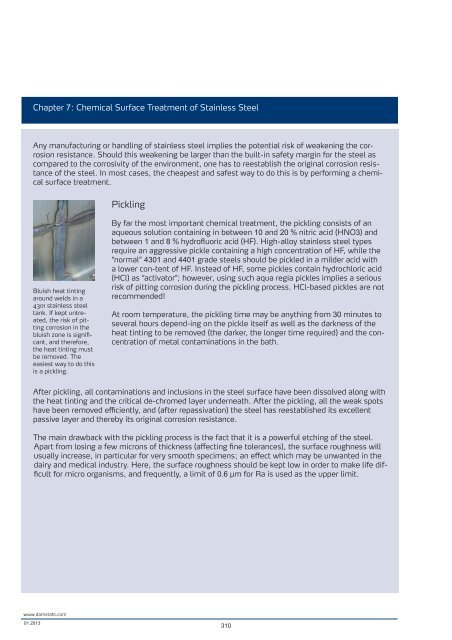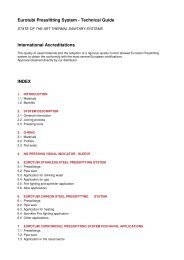- Page 1 and 2:
Produktkatalog Damstahl - a member
- Page 3 and 4:
Damstahl - a memeber of the NEUMO-E
- Page 5 and 6:
Levnedsmiddelfittings / Hygienic fi
- Page 7 and 8:
Levnedsmiddelfittings / Hygienic fi
- Page 9 and 10:
Levnedsmiddelfittings / Hygienic fi
- Page 11 and 12:
Levnedsmiddelfittings / Hygienic fi
- Page 13 and 14:
Levnedsmiddelfittings / Hygienic fi
- Page 15 and 16:
Levnedsmiddelfittings / Hygienic fi
- Page 17 and 18:
A Levnedsmiddelfittings / Hygienic
- Page 19 and 20:
Unionsoversigt Union survey DIN Sve
- Page 21 and 22:
Levnedsmiddelfittings / Hygienic fi
- Page 23 and 24:
Levnedsmiddelfittings / Hygienic fi
- Page 25 and 26:
Levnedsmiddelfittings / Hygienic fi
- Page 27 and 28:
Levnedsmiddelfittings / Hygienic fi
- Page 29 and 30:
Clampoversigt Clamp survey DIN Mini
- Page 31 and 32:
Levnedsmiddelfittings / Hygienic fi
- Page 33 and 34:
Levnedsmiddelfittings / Hygienic fi
- Page 35 and 36:
Levnedsmiddelfittings / Hygienic fi
- Page 37 and 38:
Damstahl - a memeber of the NEUMO-E
- Page 39 and 40:
Gevindfittings / Threaded fittings
- Page 41 and 42:
Gevindfittings / Threaded fittings
- Page 43 and 44:
Gevindfittings / Threaded fittings
- Page 45 and 46:
Gevindfittings / Threaded fittings
- Page 47 and 48:
Gevindfittings / Threaded fittings
- Page 49 and 50:
Gevindfittings / Threaded fittings
- Page 51 and 52:
Gevindfittings / Threaded fittings
- Page 53 and 54:
Gevindfittings / Threaded fittings
- Page 55 and 56:
Gevindfittings / Threaded fittings
- Page 57 and 58:
Gevindfittings / Threaded fittings
- Page 59 and 60:
Gevindfittings / Threaded fittings
- Page 61 and 62:
Gevindfittings / Threaded fittings
- Page 63 and 64:
Klemringsfittings / Compression fit
- Page 65 and 66:
Klemringsfittings / Compression fit
- Page 67 and 68:
Kuglehaner / Ball valves Kuglehane
- Page 69 and 70:
Svejsefittings Flanger Indhold - Sv
- Page 71 and 72:
Bøjning N112 Svejst bøjning, 90°
- Page 73 and 74:
Bøjning N112 Svejst bøjning, 90°
- Page 75 and 76:
Bøjning N113 Svejst bøjning, 90°
- Page 77 and 78:
Rørholder N114 Rørholder med svej
- Page 79 and 80:
Rørholder N115 Rørholder i par, m
- Page 81 and 82:
Konus N124 Svejste konus, koncentri
- Page 83 and 84:
Konus N 124 Svejste konus, koncentr
- Page 85 and 86:
T-stykke N127 Svejst t-stykke, opkr
- Page 87 and 88:
T-stykke N128 Svejst t-stykke, pres
- Page 89 and 90:
Endebund N140 Endebund, kløpperfor
- Page 91 and 92:
Svejsekrave N116 Svejsekraver, ISO
- Page 93 and 94:
Løsflange N118 Løsflange af alumi
- Page 95 and 96:
Løsflange N120 Løsflange, NT 16,
- Page 97 and 98:
Løsflange N121 Galvaniseret løsfl
- Page 99 and 100:
Svejseflange N123 Svejseflange med
- Page 101 and 102:
Blindflange N126 Blindflange, NT 10
- Page 104 and 105:
Damstahl - a memeber of the NEUMO-E
- Page 106 and 107:
Pressfittings / Pressfittings Muffe
- Page 108 and 109:
Pressfittings / Pressfittings Bøjn
- Page 110 and 111:
Pressfittings / Pressfittings Overg
- Page 112 and 113:
Pressfittings / Pressfittings Adapt
- Page 114 and 115:
Pressfittings / Pressfittings T-sty
- Page 116 and 117:
Pressfittings / Pressfittings T-sty
- Page 118 and 119:
Pressfittings / Pressfittings Venti
- Page 120 and 121:
Pressfittings / Pressfittings Bøjn
- Page 122 and 123:
Pressfittings / Pressfittings Rørb
- Page 124 and 125:
Pressfittings / Pressfittings Pakni
- Page 126 and 127:
Rørkoblinger Index - Rørkoblinger
- Page 128 and 129:
Rørkobling N200 Rørkobling, NT 10
- Page 130 and 131:
Rørkobling N205 Rørkobling, træk
- Page 132 and 133:
Damstahl - a memeber of the NEUMO-E
- Page 134 and 135:
Koldtvalsede plader Glødede og bej
- Page 136 and 137:
Koldtvalsede plader Slebne 1 side,
- Page 138 and 139:
Varmtvalsede båndplader Glødede o
- Page 140 and 141:
Varmtvalsede tåreplader Glødede o
- Page 142 and 143:
Stangstål / Bars Rundstål Varmval
- Page 144 and 145:
Stangstål / Bars Rundstål Varmtva
- Page 146 and 147:
5.000 m 2 på et år! Stangstål og
- Page 148 and 149:
Stangstål / Bars Rundstål, Blankt
- Page 150 and 151:
Stangstål / Bars Sekskantet Rustfr
- Page 152 and 153:
Stangstål / Bars Fladstål Varmtva
- Page 154 and 155:
Stangstål / Bars Fladstål Varmtva
- Page 156 and 157:
Stangstål / Bars Fladstål Blanktr
- Page 158 and 159:
Stangstål / Bars Fladstål Slebet
- Page 160 and 161:
Stangstål / Bars Vinkelstål Glød
- Page 162 and 163:
Stangstål / Bars b TB-profiler Las
- Page 164 and 165:
Damstahl - a memeber of the NEUMO-E
- Page 166 and 167:
Svejste stålrør Kalibrerede og gl
- Page 168 and 169:
Svejste stålrør Kalibrerede og gl
- Page 170 and 171:
Svejste stålrør Ikke glødede Wel
- Page 172 and 173:
Svejste stålrør Ikke glødede Wel
- Page 174 and 175:
SUPER DAIRY ® - reducer risikoen f
- Page 176 and 177:
Svejste levnedsmiddelrør, DS Indve
- Page 178 and 179:
Svejste profilrør Slebne eller usl
- Page 180 and 181:
Svejste profilrør Slebne eller usl
- Page 182 and 183:
Svejste profilrør Slebne eller usl
- Page 184 and 185:
Sømløse rør / Seamless tubes Sø
- Page 186 and 187:
Sømløse rør / Seamless tubes Sø
- Page 188 and 189:
Sømløse rør / Seamless tubes Sø
- Page 190 and 191:
Damstahl - a memeber of the NEUMO-E
- Page 192 and 193:
Emnerør Glødede og bejdsede Hollo
- Page 194 and 195:
Tolerancer for emnerør Rustfrie og
- Page 196 and 197:
Tolerancer for emnerør Rustfrie og
- Page 198 and 199:
Videnspakker BLUE-IQ Vælg den vide
- Page 200 and 201:
Damstahl - meget mere end rustfrit
- Page 202 and 203:
Index - Teknisk information 1 Hvad
- Page 204 and 205:
Teknisk information Kapitel 1: Hvad
- Page 206 and 207:
Teknisk information Kapitel 2: Rust
- Page 208 and 209:
Teknisk information Kapitel 3: Anve
- Page 210 and 211:
Teknisk information Kapitel 3: Anve
- Page 212 and 213:
Teknisk information Kapitel 3: Anve
- Page 214 and 215:
Teknisk information Kapitel 4: Rust
- Page 216 and 217:
Teknisk information Kapitel 4: Rust
- Page 218 and 219:
Teknisk information Kapitel 5: Ferr
- Page 220 and 221:
Teknisk information Kapitel 5: Ferr
- Page 222 and 223: Teknisk information Kapitel 5: Ferr
- Page 224 and 225: Teknisk information Kapitel 5: Ferr
- Page 226 and 227: Teknisk information Kapitel 6: Bear
- Page 228 and 229: Teknisk information Kapitel 6: Bear
- Page 230 and 231: Teknisk information Kapitel 6: Bear
- Page 232 and 233: Teknisk information Kapitel 7: Kemi
- Page 234 and 235: Teknisk information Kapitel 8: Svej
- Page 236 and 237: Teknisk information Kapitel 8: Svej
- Page 238 and 239: Teknisk information Kapitel 8: Svej
- Page 240 and 241: Kapitel 9: Tabel over de hyppigst a
- Page 242 and 243: Teknisk information Kapitel 10: Nor
- Page 244 and 245: Teknisk information Kapitel 10: Nor
- Page 246 and 247: Technical information Chapter 1: Wh
- Page 248 and 249: Technical information Chapter 2: Th
- Page 250 and 251: Technical information Chapter 3: Ap
- Page 252 and 253: Technical information Chapter 3: Ap
- Page 254 and 255: Technical information Chapter 3: Ap
- Page 256 and 257: Technical information Chapter 4: Co
- Page 258 and 259: Technical information Chapter 4: Co
- Page 260 and 261: Technical information Chapter 4: Co
- Page 262 and 263: Technical information Chapter 5: Fe
- Page 264 and 265: Technical information Chapter 5: Fe
- Page 266 and 267: Technical information Chapter 5: Fe
- Page 268 and 269: Technical information Chapter 5: Fe
- Page 270 and 271: Technical information Chapter 6: Th
- Page 274 and 275: Technical information Chapter 7: Ch
- Page 276 and 277: Technical information Chapter 7: Ch
- Page 278 and 279: Technical information Chapter 8: We
- Page 280 and 281: Technical information Chapter 8: We
- Page 282 and 283: Chapter 9: Table showing the most f
- Page 284 and 285: Technical information Chapter 9: Co
- Page 287: Damstahl a/s Danmarksvej 28 DK-8660
















